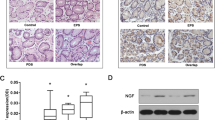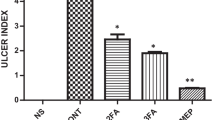Abstract
Abstract
Time-dependent changes of duodenal and gastric mucosal levels of bFGF and PDGF were examined in rats after oral administration of the duodenal ulcerogen cysteamine-HCl. The animals were killed at 12 h, 24h, 48h, 7 days or 14 days after the first dose of cysteamine and the duodenal ulcers were evaluated. The gastric and duodenal mucosa was scraped and homogenized for Western blot and ELISA studies. The ulcer formation was macroscopically detectable at 12h while the largest ulcers were seen at 48h. In parallel the duodenal mucosal concentration of bFGF increased at 12 and 24h and reached its maximum at 48h, while the PDGF concentration was slightly elevated at 12 and 48h, and a more than 3-fold peak was seen at 24h. The gastric mucosal level of bFGF and PDGF did not change during the development and healing of duodenal ulcers.
Conclusions
-
1.
The early (24–48 h) elevation of duodenal mucosal bFGF and PDGF might be a tissue-specific response to duodenal ulceration.
-
2.
These high endogenous levels of growth factors are not sufficient to prevent the ulcer formation and are not maintained in the spontaneous healing phase (7–14 days)
-
3.
Thus, bFGF and PDGF may have a role in the natural history of duodenal ulcer disease.
Similar content being viewed by others
References
Poulsen SS, Olsen PS, Kirkegaard P. Healing of cysteamine-induced duodenal ulcers in the rat. Dig Dis Sci. 1985;30:161–7.
Konturek SJ, Brzozowski T, Dembinski A et al. Gastric protective and ulcer-healing action of epidermal growth factor. In: Garner A, Whittle BJR, eds. Advances in Drug Therapy of Gastro-intestinal Ulceration. New York: John Wiley and Sons; 1989:261–73.
Szabo S, Folkman J, Vattay P et al. Duodenal ulcerogens: The effect of FGF on cysteamine-induced duodenal ulcer. In: Halter F, Garner A, Tytgat GNJ, eds. Mechanisms of Peptic Ulcer Healing. London: Kluwer Academic Publishers; 1991:139–50.
Szabo S, Folkman J, Vattay P, Morales RE, Pinkus GE, Kato K. Accelerated healing of duodenal ulcers by oral administration of a mutein of fibroblast growth factor in rats. Gastroenterology. 1994;106:1106–11.
Wolfe MM, Bynum TE, Parsons WG et al. Safety and efficacy of an angiogenic peptide, basic fibroblast growth factor (bFGF), in the treatment of gastroduodenal ulcers: A preliminary report. Gastroenterology. 1994;106:A212.
Vattay P, Gyömbér E, Morales RE et al. Effect of orally administered platelet-derived growth factor (PDGF) on healing of chronic duodenal ulcers and gastric secretion in rats. Gastroenterology. 1991;100:A180.
Kusstatscher S, Szabo S. Effect of platelet-derived growth factor (PDGF) on the healing of chronic gastritis in rats. Gastroenterology. 1993;104:A125.
Selye H, Szabo S. Experimental model for production of perforating duodenal ulcers by cysteamine in the rat. Nature. 1973;244:458–9.
Szabo S. Animal model of human disease: duodenal ulcer diseases. Animal model: cysteamine-induced acute and chronic duodenal ulcer in the rat. Am J Pathol. 1978;93:273–6.
Szabo S, Cho CH. From cysteine to MPTP: structure-activity studies with duodenal ulcerogens. Toxicol Pathol. 1988;16:205–12.
Kusstatscher S, Sandor Z, Satoh H et al. Inhibition of endogenous, basic fibroblast growth factor (bFGF) delays duodenal ulcer healing in rats: Implication for a physiologic role of bFGF. Gastroenterology. 1994;106:A113.
Bradford MM. A rapid and sensitive method for quantitation of microgram quantities of protein utilizing the principle of protein-dye binding. Anal Biochem. 1976;72:248–54.
Watanabe H, Hori A, Seno M et al. A sensitive enzyme immunoassay for human basic fibroblast growth factor. Biochem Biophys Res Commun. 1991;175:229–35.
Harrison AA, Dunbar PR, Neale TJ. Immunoassay of platelet-derived growth factor in the blood of patients with diabetes mellitus. Diabetologia. 1994;37:1142–6.
Sasahara M, Fries JWU, Raines EW et al. PDGF, B-chain in neurons of the central nervous system, posterior pituitary, and in a transgenic model. Cell. 1991;64:217–21.
Author information
Authors and Affiliations
Rights and permissions
About this article
Cite this article
Vincze, A., Nagata, M., Sandor, Z. et al. Elisa and western blot studies with basic fibroblast growth factor (bFGF) and platelet-derived growth factor (PDGF) in experimental duodenal ulceration and healing. Inflammopharmacol 4, 261–265 (1996). https://doi.org/10.1007/BF02731876
Received:
Accepted:
Issue Date:
DOI: https://doi.org/10.1007/BF02731876




